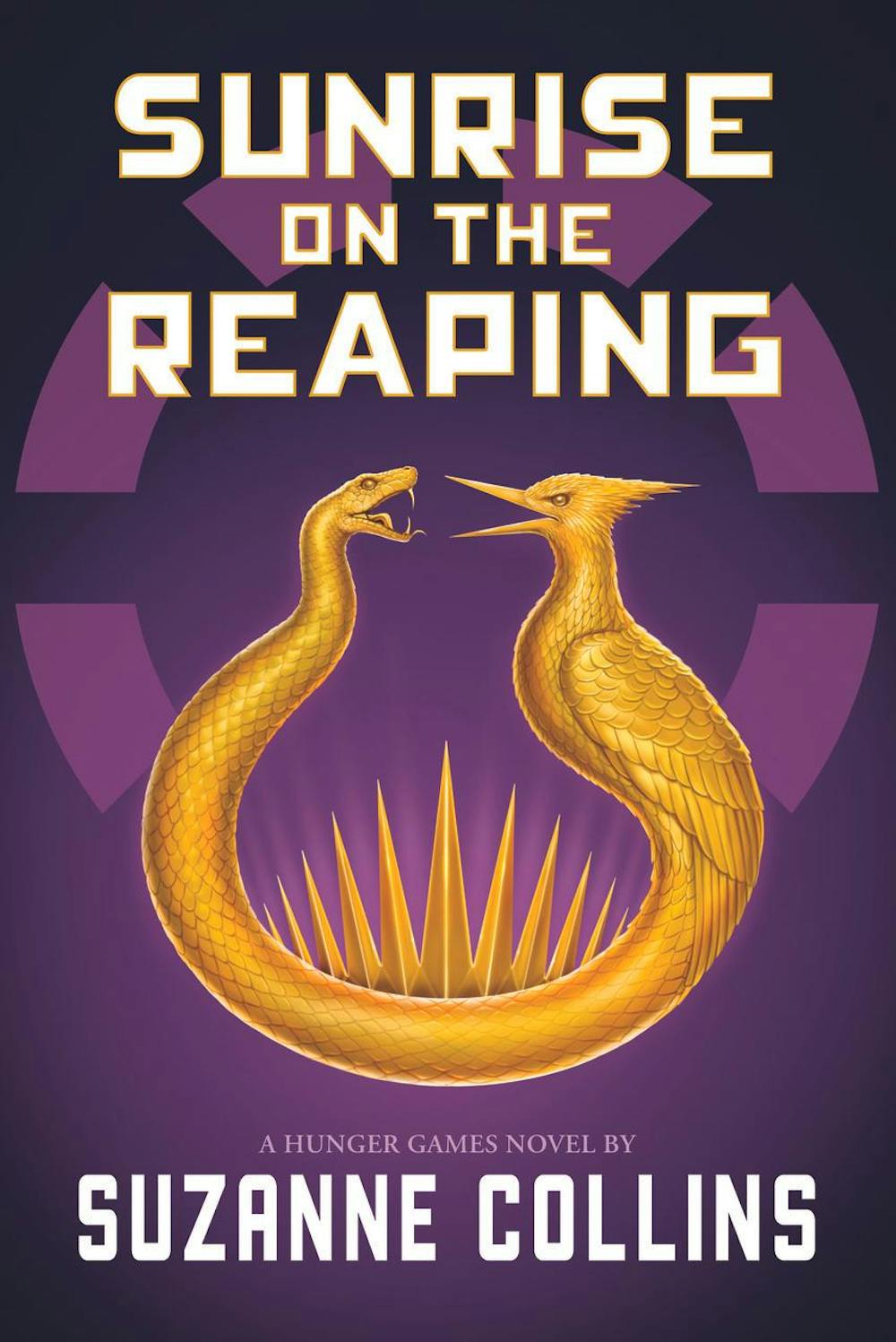The opinions and views expressed in this article are those of the author and do not reflect the opinion of Byte or Byte’s editorial board.
Warning: this review contains many spoilers for Sunrise on the Reaping
Suzanne Collins once again takes us back to the haunting world of Panem with Sunrise on the Reaping. This time, the novel is told from the perspective of a 16-year-old Haymitch Abernathy, years before he mentors Katniss Everdeen and Peeta Mellark in the 74th Hunger Games. Instead, we follow Haymitch through the events surrounding the 50th Hunger Games and can immediately get the sense that this story will include much more explicit mentions of violence than the original trilogy. Both of the prequels—Sunrise on the Reaping and The Ballad of Songbirds and Snakes (TBOSAS)—have a distinctly more sinister undertone, something that is difficult to achieve when even the original trilogy is disturbing in and of itself.
This book manages to tie the events from TBOSAS and the original The Hunger Games series together in a way that is deeply unsettling and leaves the reader with feelings of dread for days. That being said, it also holds some strangely hopeful messaging in the idea that nothing—not even revolution—happens overnight.
The Odds Are Not in Anyone’s Favor
One of the first moments where we realize that we don’t know as much as we thought is learning the circumstances that surround Haymitch going into the Hunger Games in the first place. We find out that Haymitch was not reaped in the way that tributes traditionally were. While his selection is still somewhat random and based mostly on unfortunate timing, the nontraditional means with which he enters the Games crack open a world of horrific possibilities. This is the first introduction within this book to the cruelty of Coriolanus Snow and the Capitol. It is of course known that the Capitol and Snow are horrible from the original series and TBOSAS, but Sunrise on the Reaping somehow manages to shed even more light on the true evil of these entities.

Still of Snow in Catching Fire provided by Lionsgate.
Beginning with Haymitch being handpicked for the Games, we begin to see other sinister aspects of Snow and the Capitol that were hidden from Katniss’ perspective. Haymitch is a much more aware narrator than Katniss and is able to provide a lot more insight into the horrors of the Games. In addition to this, the book makes it clear as to why Haymitch truly understood everything that Katniss went through in the original trilogy. All moments of Haymitch’s story are met with absolutely horrifying events orchestrated by Snow, but one of the ones that stands out the most is the replacement of Louella. The idea that Snow found, tortured, and hijacked a child from District 11 in order to replace Louella haunts the narrative from the moment that this is revealed. Even after the death of Lou Lou in the Games, Haymitch continues to reflect back on her and the horrors she was put through when thinking about the ways in which Snow has manipulated truth and terrorized the District people. This book does a truly impressive job at continuing to villainize Snow and show how truly unforgivable his actions are throughout the series.
A Big, Big, Big Day

Still of Haymitch and Plutarch in Catching Fire provided by Lionsgate.
Going into reading this book, I knew that there would be at least a few recognizable characters—outside of Haymitch—that readers would know from other novels, but I was not prepared for how many familiar faces we would see. Effie Trinket, Plutarch Heavensbee, Mags, Wiress, both of Katniss’ parents, Peeta’s father, Caesar Flickerman, and many members of the Covey were all included throughout the story. Haymitch’s story allows us as readers to have a glimpse into the early lives of so many other characters from the other books. The reveal that Mags and Wiress were actually Haymitch’s mentors was a shocking twist. We are finally able to put names to Katniss’ parents: Burdock and Asterid. We also find that Burdock was one of Haymitch’s closest friends. Witnessing the devolution of this friendship is hard to watch and made even more painful with the knowledge that Haymitch will one day have to mentor Burdock’s daughter.
An especially interesting facet of character expansion is done in terms of Plutarch. While he is a rebel, he also actively participates in and profits off of the suffering of District people. He is a primary force in producing Capitol propaganda. We have some insight into these concepts in Mockingjay, but Sunrise on the Reaping makes it clear how strange this disconnect is. Plutarch’s position within the universe of Panem is strangely reminiscent of modern day celebrity activism. There is definitely lots to be explored in the symbolism of Plutarch participating in the rebellion while also sitting comfortably in the Capitol and benefiting from the institution of the Hunger Games.
The Many Faces of the Rebellion
This book reveals that the rebellion was not a spontaneous event that happened during Katniss’ lifetime. In fact, she was not the one to even start it in the first place. The rebellion against the Capitol had been brewing in different forms and through different generations for years. You could even argue that Lucy Gray was a part of this. We certainly see that Beetee, Mags, Wiress, and even Plutarch had been part of the rebellion since even before the 50th Hunger Games. Haymitch plays a much more involved role than readers could ever previously have known. The existence and prevalence of the rebellion throughout each of the books within this series proves that there was always a spark of hope to be found even during the gruesome 50th Games.

It would be a disservice to review this book without mentioning the central theme of propaganda. Suzanne Collins is known for her distinctive themes within the books that she writes and has often stated that her primary reason for returning to a series is to explore specific serious themes that are applicable in the real world. In the case of Sunrise on the Reaping, propaganda was the primary focus. This is evident from the very first page of the book in which the page that usually holds other authors’ reviews is instead various quotes from George Orwell, William Blake, and David Hume. These quotes give readers an immediate understanding that this book tackles incredibly relevant and specific themes all connecting to propaganda. Collins is able to connect these themes to modern day events expertly throughout the book; from her minor mention of AI technology to her broader connections to today’s political climate, this novel puts so much into perspective. Plutarch’s role in this book contributes to the propaganda theme in that he is often the one behind the camera for the Capitol. Additionally, Haymitch and Maysilee make reference to “painting a poster” when they want to be covert about rebelling in the arena. This powerful imagery is a distinct reminder of the propaganda theme at a time in which it could be the easiest for readers to forget. All of this just goes to show that Collins is incredibly successful once again in weaving in relevant themes to the world of Panem.
There Are Much Worse Games to Play
There are lots of heartbreaking moments within this book—almost too many to recount—but one that really stuck out for me was Burdock’s singing of “The Old Therebefore.” There are many instances in this book in which songs are sung, and many of them are ones that have not appeared in the other novels and thus have not been heard before. However, this song in particular made an appearance in TBOSAS book and movie. The reveal that "The Old Therebefore" is a funeral song provides new context to Lucy Gray singing it during her time in the arena; she is singing her own funeral song. Within Sunrise on the Reaping, the song makes it evident how much Haymitch has lost. It is immediately devastating, but the inclusion is incredibly necessary.
Another emotionally gutting moment comes soon after the singing of this song. The epilogue of Sunrise on the Reaping is only two pages, but don’t let that fool you: these pages are a beautiful ending to the novel and the series as it currently stands. Not only is this epilogue absolutely heartbreaking, but it also connects to the epilogue of Mockingjay. We get a short yet valuable glimpse into Haymitch’s perspective of life after the revolution that I never knew I needed.
While I absolutely love Suzanne Collins’ writing and her clear purpose with which she navigates through the universe of The Hunger Games, I would not be surprised—nor disappointed—if this was the final book of this series. Sunrise on the Reaping offers an unsettling but satisfying conclusion to the stories of each of the characters. It leaves readers feeling a deep sense of sorrow for the characters, almost mourning the losses that they experience. At the same time, the connection to the ending of Mockingjay and the small references within it makes it a perfect ending to a beautifully written novel and series.

Sources: SuzanneCollinsBooks, Goodreads, Goodreads, Goodreads, Goodreads, SuzanneCollinsBooks, OrwellFoundation, PoetryFoundation, Britannica, Spotify
Photos: SuzanneCollinsBooks, Lionsgate, Lionsgate, Lionsgate
Contact Willow Emig with comments at willow.emig@bsu.edu.



















